◀ VISUAL ARTS ▶
HERE, NOW AND FOREVER
KATHRYN WEIR This essay is part of the exhibition catalogue The Cloud of Unknowing by Ho Tzu Nyen, published for the Singapore Pavilion at the 54th International Biennale of Art, Venice 4th June to 27th November 2011. An earlier version of this essay was published by the Contemporary Art Centre of South Australia, Adelaide, for the exhibition Ho Tzu Nyen 2010, as part of CACSA Projects, April-May, 2010.
This essay is part of the exhibition catalogue The Cloud of Unknowing by Ho Tzu Nyen, published for the Singapore Pavilion at the 54th International Biennale of Art, Venice 4th June to 27th November 2011. An earlier version of this essay was published by the Contemporary Art Centre of South Australia, Adelaide, for the exhibition Ho Tzu Nyen 2010, as part of CACSA Projects, April-May, 2010.
 Ho Tzu Nyen, EARTH, 2009
Ho Tzu Nyen's EARTH (2009) stages an unspecified disaster: fifty bodies, dead or dying and coming in and out of consciousness, blend with a piled up morass of detritus, crates and branches, surrounded by dark water. A summation of world history and its debris, the assemblage of bodies stands in for the whole of humanity and the fleshy immanence of all human striving. Individuals or vignettes catch our attention and then recede into the variegated whole, the larger organism engaged in a struggle to survive that draws painful breath through each constituent element. Small gestures and movements are carefully choreographed: a finger pointing, a head pushed forwards by a disembodied hand, a prone figure raising himself like a supplicant. The artist states that he seeks "to communicate only at the level of the nervous system" with "works that are neither figurative nor abstract, but fields of concrete sensations." This translates to an emphasis on physicality, whether in the physiognomy and measured movements of the actors, or in the sound design and music conceived to make audience members aware of themselves, through, for instance, the use of base frequencies that create perceptible bodily vibrations. The here and now of EARTH, is felt as much as seen. Free of dialogue or voiceover, the work has been performed and recorded in a number of different sound iterations, with music and found noise in each case inflecting how it may be understood.
Ho Tzu Nyen, EARTH, 2009
Ho Tzu Nyen's EARTH (2009) stages an unspecified disaster: fifty bodies, dead or dying and coming in and out of consciousness, blend with a piled up morass of detritus, crates and branches, surrounded by dark water. A summation of world history and its debris, the assemblage of bodies stands in for the whole of humanity and the fleshy immanence of all human striving. Individuals or vignettes catch our attention and then recede into the variegated whole, the larger organism engaged in a struggle to survive that draws painful breath through each constituent element. Small gestures and movements are carefully choreographed: a finger pointing, a head pushed forwards by a disembodied hand, a prone figure raising himself like a supplicant. The artist states that he seeks "to communicate only at the level of the nervous system" with "works that are neither figurative nor abstract, but fields of concrete sensations." This translates to an emphasis on physicality, whether in the physiognomy and measured movements of the actors, or in the sound design and music conceived to make audience members aware of themselves, through, for instance, the use of base frequencies that create perceptible bodily vibrations. The here and now of EARTH, is felt as much as seen. Free of dialogue or voiceover, the work has been performed and recorded in a number of different sound iterations, with music and found noise in each case inflecting how it may be understood.
The space is presented in three takes which sweep across the scene as though it were two-dimensional and, at particular points, move from detail to wide angle. The camera takes off from the ripples on a pool of dark water, then directs the eye across limbs and flesh, from illumination to shadow, across faces and along diagonals. From a centrally placed blindfolded character, the frame pulls out to reveal the full composition, then returns to the details of bodies, until coming to rest on a wounded figure who contemplates his double in the black pool of water. Ripples dissolve his narcissistic gaze into velvety black void. The whole seems less a tableau vivant – first developed in the theatre as a highly composed and emotionally charged freeze frame which interrupts the action – than a tableau tout court, functioning as it does throughout as a filmed, living painting. To create his composition, Ho drew on specific Italian and French paintings of the 17th, 18th and 19th centuries that emphasise the materiality of bodies or convey a sense of "being there". The figures on the apex are inspired by those in Théodore Géricault's The Raft of the Medusa (1818-1819), and these rest upon groupings from Eugene Delacroix's Massacre at Chios (1824), Anne Louis Girodet de Roussy-Trioson's The Revolt at Cairo (1810), and Antoine-Jean Gros' Napoleon Bonaparte visiting the plague victims at Jaffa (1804) – all of which powerfully evoke the settings and subjects of notorious battles and disasters.
Paintings by Caravaggio provide the point of departure for three key sequences. A disoriented man points towards his neighbour's abdomen, reproducing the gesture, portrayed by Caravaggio in The Incredulity of Saint Thomas (1601-1602), of doubting Thomas placing a finger in the resurrected Christ's wound; he has to see, or rather, feel, this flesh wound in order to believe. An extended sequence of a head with a hand controlling it and pushing it rhythmically forwards finds its genesis in Caravaggio's late painting of the biblical David and Goliath story, David with the Head of Goliath (1609-1610), where the decapitated head of Goliath in David's hand is believed to bear Caravaggio's features. This disembodied head of a giant condemned by God – bearing the artist's self-portrait at a time of despair near the end of his life – is reworked by Ho, who lends the hand a rhythmic movement representing control and resistance; these elements are given centre stage in TESLA (2009). EARTH's closing image of a figure looking at his reflection in the black water appears in Ho's production design images as Caravaggio's Narcissus (1598-1599). The doubling of the film's endpoint through the reflection, which returns to the point of departure in the dark waters, reveals the eternal cycle of the here and now depicted in a narcissistic mise-en-abime, an endless, self-referencing repetition.
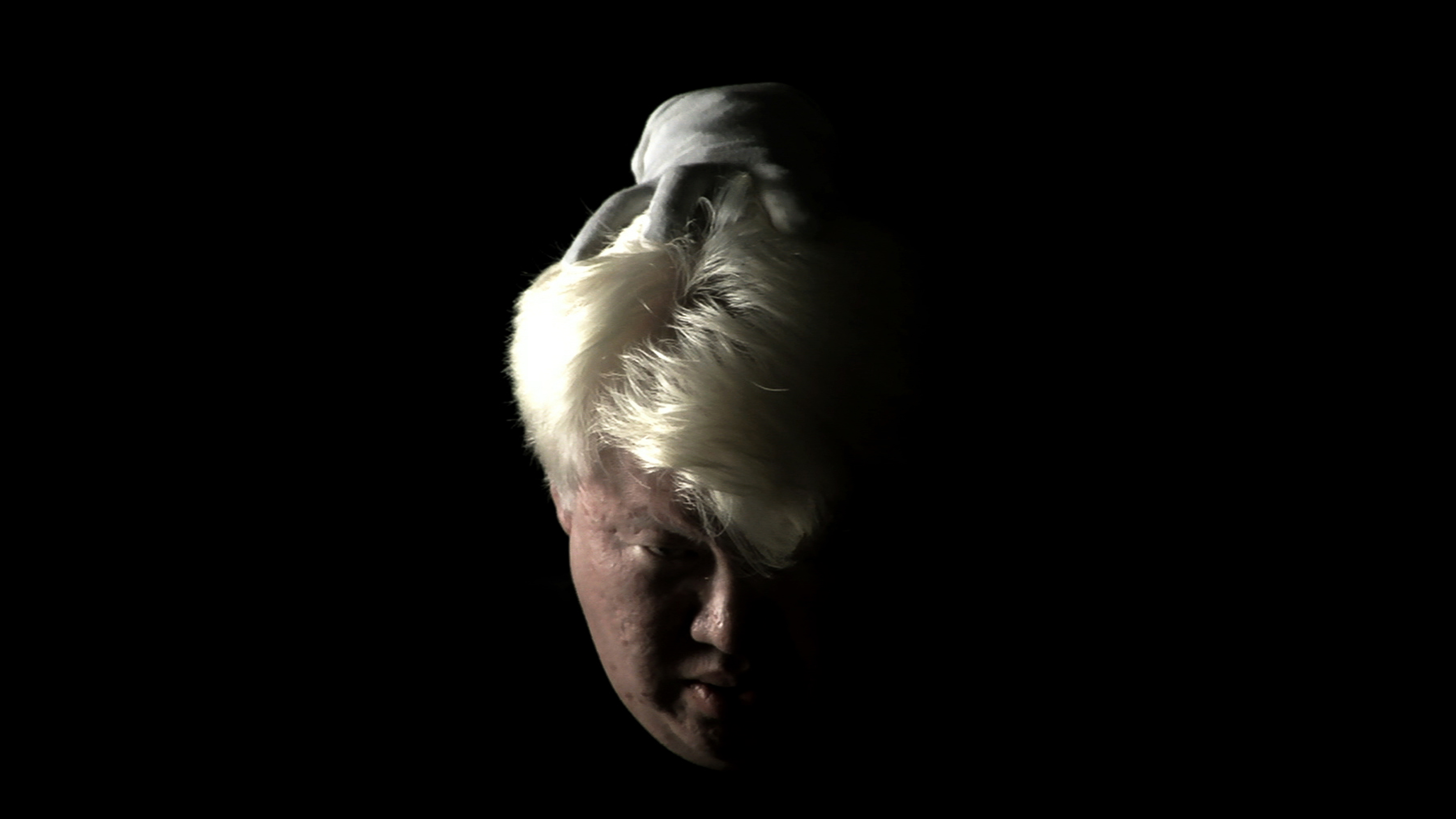
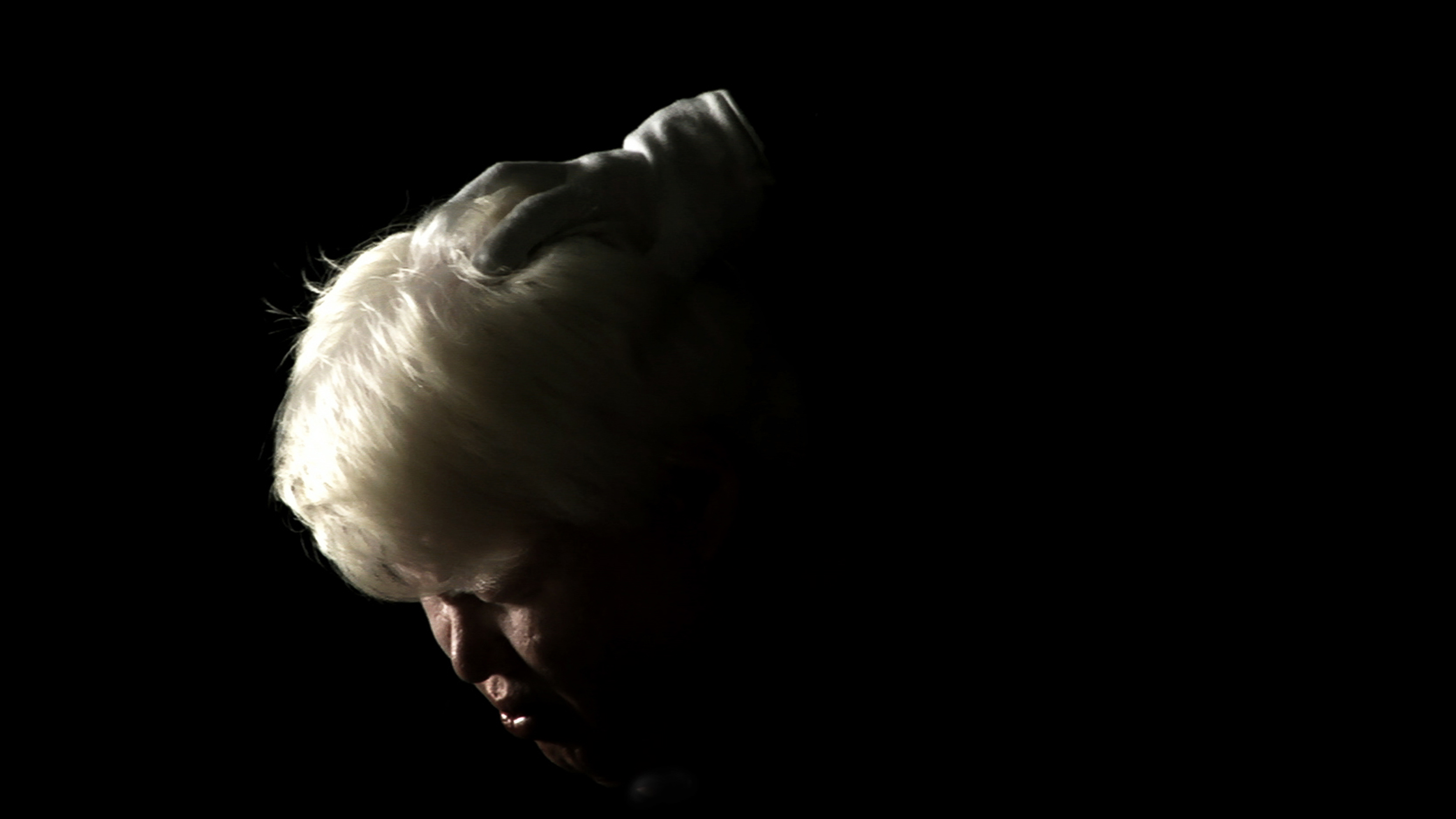
Ho Tzu Nyen, TESLA, 2013
In the five-channel installation, TESLA, five head shots of the same white-haired actor – from the front, and from either side at 45 degrees and in profile – are presented in an audio environment of high-pitched electronic buzz. A white-gloved disembodied hand on the actor's head pushes forwards as the sound levels increase and peak, seeming to transmit a force while the actor resists and looks uncomfortable or in pain. The work functions metaphorically in a number of related ways. At one level, it provides an embodied representation of the physical nature of alternating current, the alternative system to direct current for delivering electrical power elaborated by Nikola Tesla at the beginning of the last century. Alternating current moves in one direction and then the other, surging and subsiding in intensity in each direction. In TESLA the head moves forward as the hand pushes like a surge of current against the head's resistance, then as the surge decreases to the still point of the current's reversal, the head moves back to neutral. Allegorically, the work can be seen to figure the broader dialectics of power and resistance. At another level of abstraction again, it demonstrates a pattern that while constantly changing always repeats itself, a broad brushstrokes equivalent to Friedrich Nietzsche's eternal return.
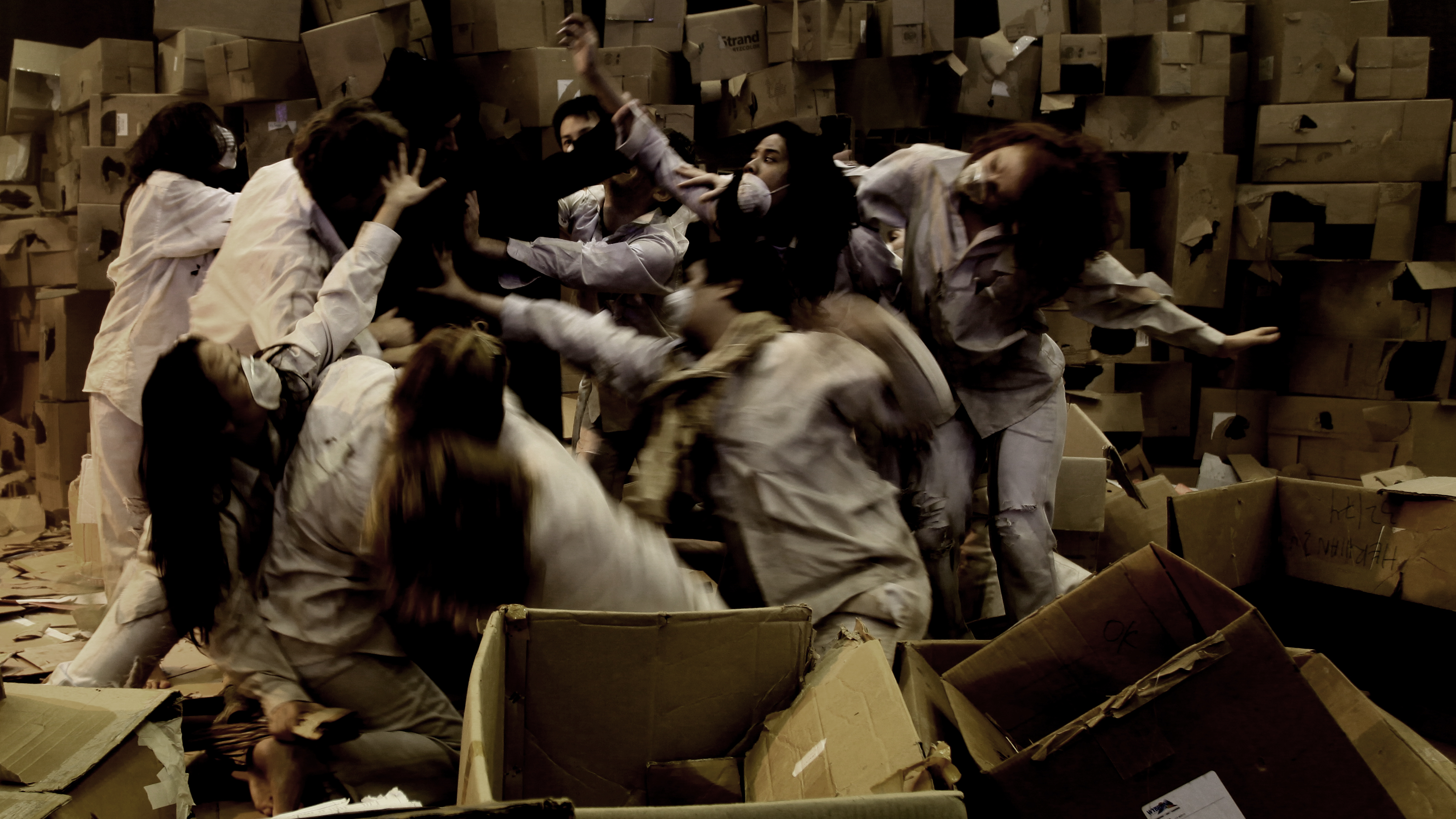
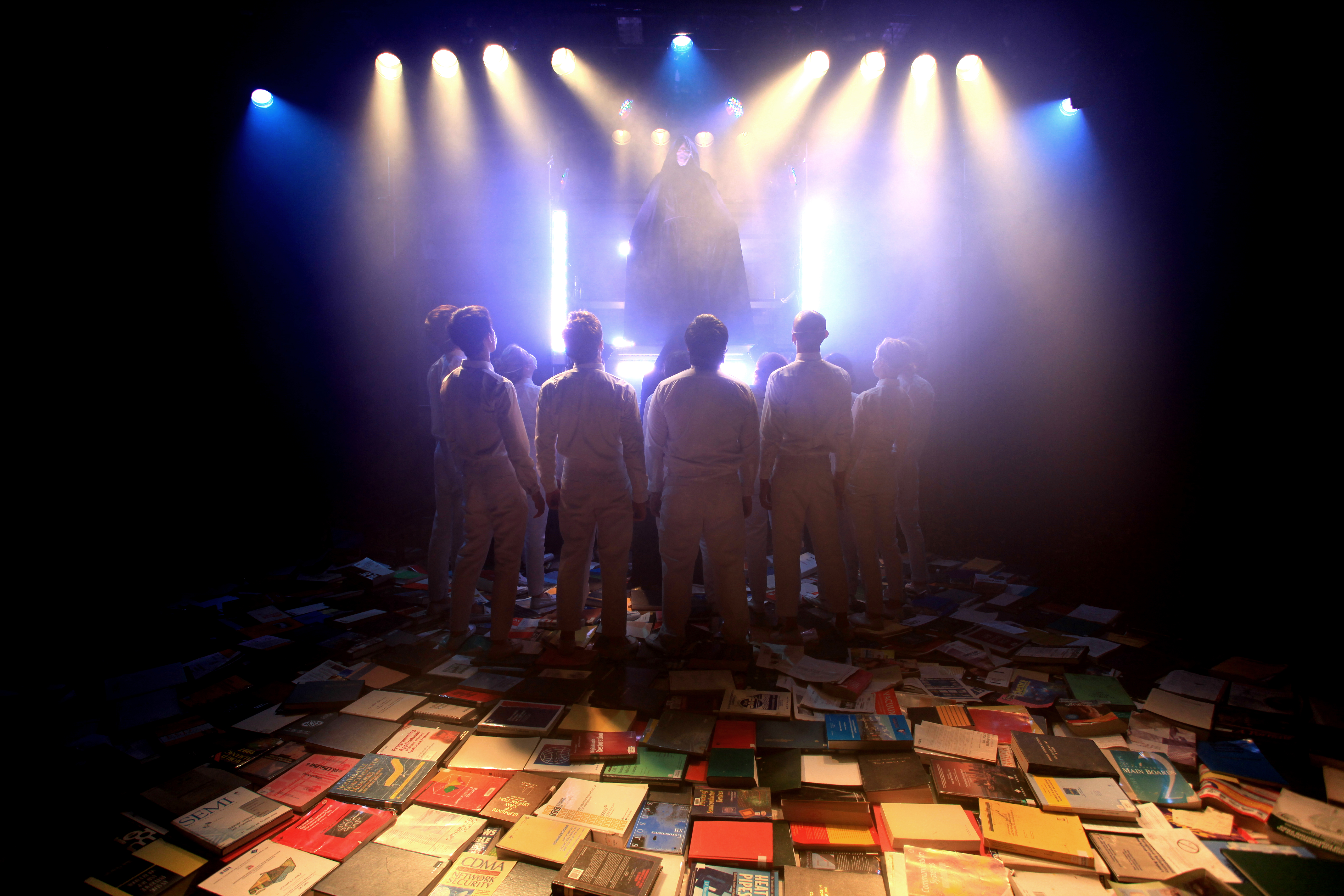
Ho Tzu Nyen, Zarathustra: A Film for Everyone and No One, 2009
This theory of constant change and cyclic return experienced in the here and now is most directly addressed by Ho in Zarathustra: A Film for Everyone and No One (2009). The film is a response to and condensed enactment of Nietzsche's Thus Spoke Zarathustra: A Book for Everyone and No One (1883-1885); the artist has also described it as a "doom-metal opera" and "a speeded up version of EARTH." Like EARTH, Ho's Zarathustra was produced in controlled studio conditions, and its choreography of bodies and other elements is very theatrical. Where EARTH was filmed in three long takes and, as previously discussed, recreates the experience of viewing a two-dimensional painting, Zarathustra is captured in a single take, which moves forward and back through the studio, immersing the viewer in three-dimensional space.
Created through a collaborative, pedagogic process, Zarathustra was offered as a tertiary course for fifty students specialising in film, musical theatre, acting, fine arts and music at LASALLE College of the Arts in Singapore. The artist presented his concept to the students, taking as his point of departure Nietzsche's concept of the eternal return:
What if some day or night a demon were to steal after you into your loneliest loneliness and say to you: "This life as you now live it and have lived it, you will have to live once more and innumerable times more; and every pain and joy and thought and sigh must come again to you, all in the same sequence"... Would you throw yourself down and gnash your teeth and curse the demon who spoke thus? Or would you have answered him: "You are a god and never have I heard anything more divine."
Many students may have laughed nervously, glanced at their neighbour and raised their eyebrows to suggest that Ho was being overly dramatic. The artist's performative lecture style and his broader practice play on this dramatic effect. This is the very drama – that heightens awareness and calls on us to truly experience the here and now – to be found in Ho's multifarious sources, from Caravaggio to heavy metal music, from post-Revolutionary French painting to the revolutionary visions of inventor Nikola Tesla, from Nietzsche to the tableau vivant. This train wreck of an existence, Ho is reminding the students, this battlefield littered with corpses and punctuated by shafts of light: art and all things emerge within this; there is no escape from its endless cycles of repetition, but you may transform some part of it and yourself, not least through creative work.
The pedagogic impulse is also the point of departure for Nietzsche's text, which tells in the "Prologue" of Zarathustra's decision, after ten years alone in the mountains, to go down and teach, to share the wisdom he has gained. Ho's film shows Zarathustra preaching in front of a rock concert stage, delivering through music and a chorus of moans Nietzsche's message of overcoming present unconsciousness and God-less malaise through striving for radical self-determination. The crowd of head-banging pleasure-seekers quickly loses interest, even as Zarathustra points to gold emerging from under the rubbish strewn across the earth. Their attention is drawn by Zarathustra's identical double on the stage who points up to the light set to illuminate rock idols. On the shoulders of the double appears a small, hooded figure, Nietzsche's dwarf, representing weight or gravity. The double collapses under this weight, falls sick and dies. Zarathustra carries the double away to be buried, then collapses himself under the burden. Ho continues to visually recount the key moments of Nietzsche's text, using a dense soundtrack and the relentless displacement of the camera to disorient and discomfort the viewer. In Nietzsche's text Zarathustra must overcome his revulsion at the state of humanity and accept that there is no possibility of progress, just endless repetition, including of the basest moments of human nature and history. To escape from the paralysing implications of the state of eternal recurrence, Zarathustra affirms the present as the moment of possible transformation when life is enacted through intense engagement.
Zarathustra: A Film for Everyone and No One presents humanity's shared predicament, as diagnosed by Nietzsche, in a dark world of weights and flows. In Ho's short video work NEWTON (2009), on the other hand, everything is white and bathed in light. The work opens with a perfectly symmetrical, frontal image of three white books on a white shelf, accompanied by a deep drone of throat singing; the middle book slowly slides out and falls as a cat purrs loudly. A white-haired man's somnolent face appears, then, with a sound of wings beating, the book falls on his head.
We see a hand smoothing out an opening of the book, then a white computer and keyboard and hands typing. A printer delivers a sheaf of paper; the man clips these to a board, takes a loud hailer and shouts, "Action!" We see in profile a finger pushing a book from amongst those on a shelf, then the film loops and begins again with the frontal image of the book falling.
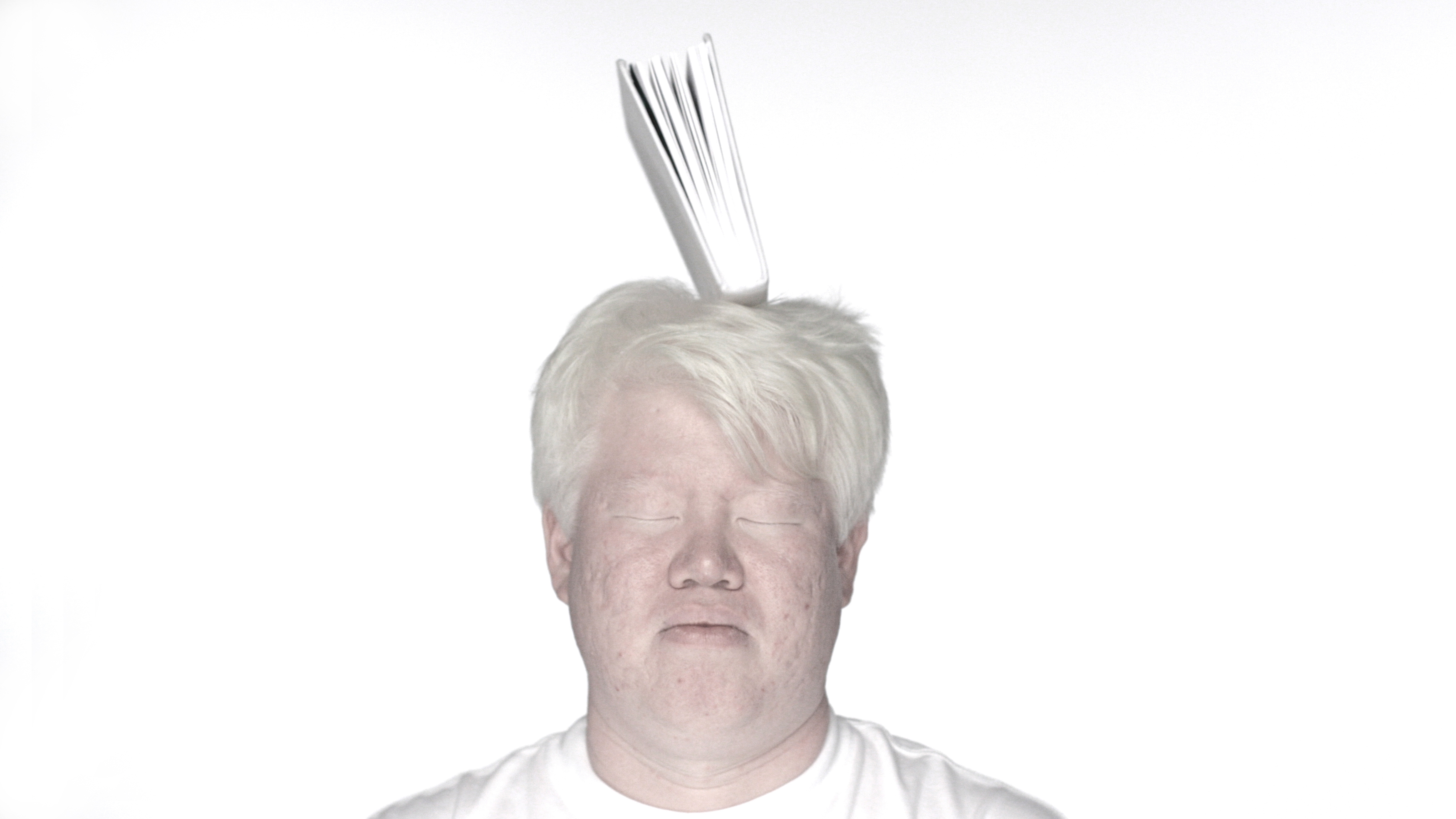
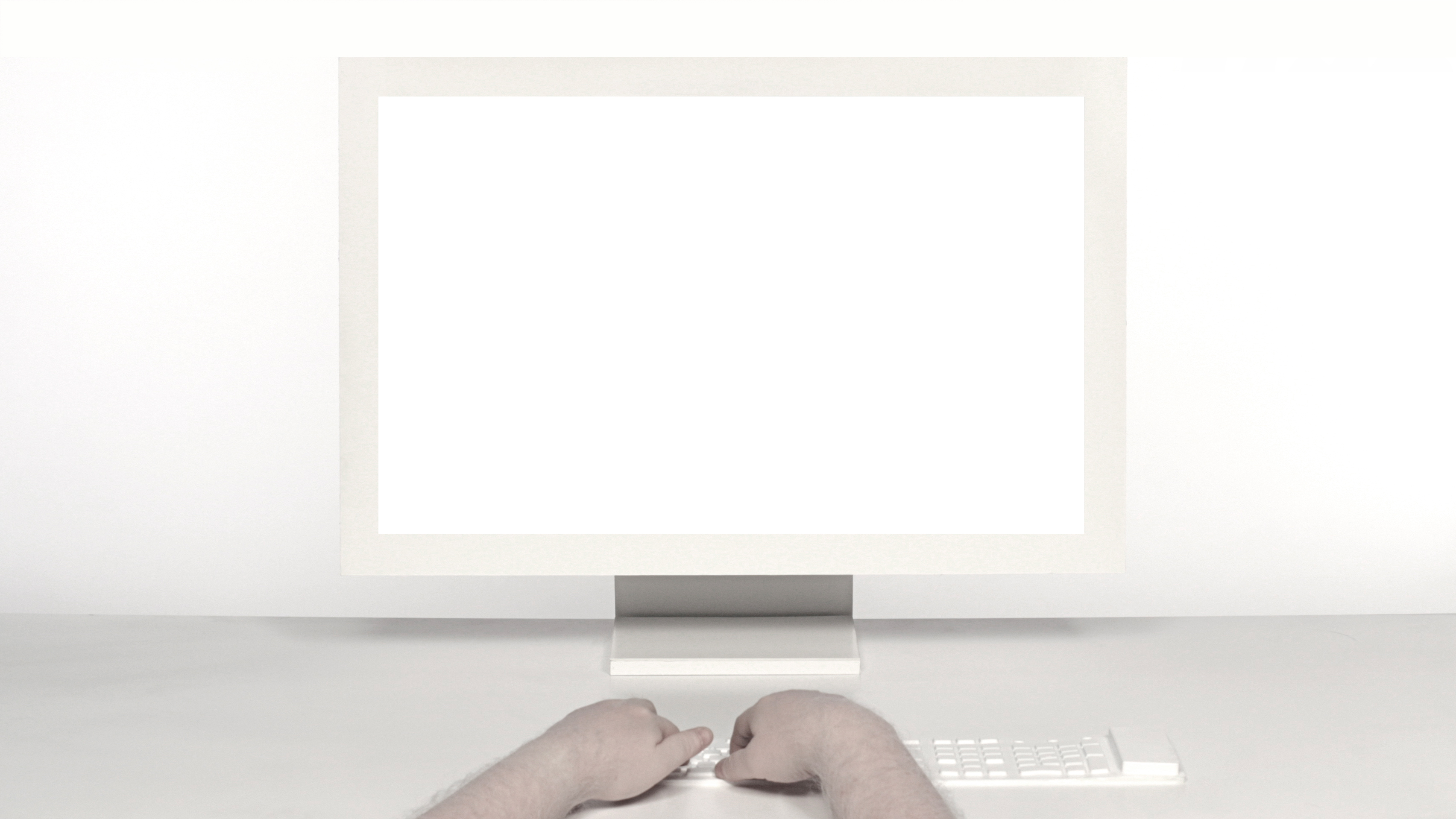
Ho Tzu Nyen, NEWTON, 2009
The reference to Newton clearly calls up the story, considered likely apocryphal, of the genesis of the general theory of gravitation in an incident where the celebrated seventeenth century physicist was hit on the head by an apple while taking tea in the garden. In Ho's NEWTON, the director artist is hit on the head not by a ripe apple, naturally falling from the tree, but by a book, a text, a work that has gone before, raining from the sky like stone tablets on Mount Sinai. The book imposes its sacred covenant to create; the artist director transforms it into a project or script, and then takes a loudhailer, utters the work's single word of dialogue, and starts to make a film. A finger pushes the book, and the loop recommences. Made up of eight shots of around eight seconds each, NEWTON presents an environment governed by simple, mechanistic laws. The finger pushing the book off the shelf recalls the finger pointing to the abdomen in EARTH seeing and believing, cause and effect. Ho stages the intervention of a chance occurrence in the creation of a work of art, while simultaneously suggesting that in the process of creation, nothing is left to chance. Even the moment of "inspiration" must be staged in a highly controlled and choreographed environment in order to then rework, repeat and transform what has already been created. Ho Tzu Nyen, the artist director directing NEWTON's artist director, is here making light of the serious undertaking of artistic creation, while also affirming that there is no other option than to go on striving for the moments of transformative action which it enables.
1. Developed in response to a commission by the Singapore Arts Festival (2009), EARTH was first presented in a theatrical setting in "Invisible Room", and featured live music from Singapore band The Observatory. As the work was created with this performance in mind, the camera movements and key sequences or vignettes are choreographed in relation to the timing of the songs to be performed by The Observatory: RPK/Blood Rising, Decarn, Ephemeron, Incastrate, Lowdown, Invisible Room and Omicron. The work exists in a number of recorded versions, notably (((radio))) and [cinema]. The soundtrack of EARTH [cinema] was first presented live with sound by Japanese field recordist/sound designer Yasuhiro Modnaga and music by electro-acoustic/drone guitarist Stefano Pilia when EARTH screened at the 66th Venice International Film Festival. Yasuhiro Morinaga's recorded sounds register as an encyclopedia of the madness and passions of the earth. EARTH (((radio))) is dedicated by the artist to "his generation" and the soundtrack features riffs and remixes from tracks including Queen's Bohemian Rhapsody, the basis for Ho's earlier work The Bohemian Rhapsody Project (2006), Michael Jackson's Thriller and Survivor's Eye of the Tiger.
2. Unpublished artist's statement.
3. See "director's interview" for Ho's first feature film HERE (2009): "I am extremely interested in the moment when sound takes on a life of its own and frees itself from demands of synchronisation. I am also intrigued with the physical properties of sound, especially the extremely high and low frequencies that stretch the experience of listening. I think that the act of listening has a special connection to the sense of being "here". There is always a kind of distancing inherent in the act of seeing. But sound is experienced by the entire body, and is something immediate and physical."
5. Ho previously used the tableau vivant as an interruption to the action in "Tang Da Wu — The Most Radical Gesture" in 4 x 4: Episodes of Singapore Art (2005) and in The Bohemian Rhapsody Project (2006). See Kevin Chua "Ho Tzu Nyen's Criminal Tableaux", 2007, Contemporary Art Centre of South Australia (exhibition catalogue), who argues in relation to these works that: "What Ho's work is attuned to is not modernism as a purification of medium (painting or film), but a dialectical understanding of how modernist form emerges out of – is a deep response to – the matrix of modernity. At issue in his work is less the freezing of action per se, than how the tableau as form is bound up with – is inextricable from – the social experience of modernity in Singapore. To leave the earth in a bid for purity, to recklessly surmount one's rootedness in the world, is the primordial crime of representation." There is a strong resonance between Ho's EARTH and a work of theatre first performed in New York in 1969, Samuel Beckett's Breath. Breath was written in 1966 and is Beckett's shortest theatrical work at 35 seconds, The script sets out three movements, just as EARTH is divided into three takes:
1. Faint light on stage littered with miscellaneous rubbish. Hold about five seconds.
2. Faint brief cry and immediately inspiration and slow increase of light together reaching maximum together in about ten seconds. Silence and hold for about five seconds.
3. Expiration and slow decrease of light together reaching minimum together (light as in1) in about ten seconds and immediately cry as before. Silence and hold about five seconds. Beckett's Breath distills human life into two disembodied cries, birth and death, and the sound of an inhalation and exhalation. EARTH's vision is incarnate: human life and history remain immanent in writhing bodies. In "Beckett on Film" (2000), Damien Hirst directs Breath for the screen. His "miscellaneous rubbish" is hospital detritus – trolleys, monitors, syringes, sterile materials, plastic bags – all piled on a platform spinning through a void. The last elements seen as light fades are a cigarette ashtray and the butts within it forming a swastika. See Beckett on Film: 19 films by 19 directors, released on DVD by Blue Angel Films, 2001.
6. First commissioned for the 6th Asia-Pacific Triennial of Contemporary Art (2009-2010), by the Queensland Art Gallery / Gallery of Modern Art, Brisbane.
7. Personal communication.
8. Friedrich Nietzsche, The Gay Science (1882).
9. Amor fati, another key Nietzschean concept meaning the love of fate, is explored by Ho elsewhere through a character in his feature film, HERE (2009). The film is staged as a documentary shoot in a psychiatric hospital in which patients participate in a new form of therapy, the video cure, and enact for the doctors' camera an improved version of past crimes and misdemeanors. One patient refuses to complete the video cure, as he prefers to affirm his own past, referring to amor fati.
10. Ho's sound design often introduces elements which do not correlate with the image, rather eliciting an independent emotional reaction from the viewer and even physical effects of disorientation; this emerges from the artist's interest in the physicality of non-diegetic sound (the source of which is neither visible on the screen, nor necessarily implied by the action).









